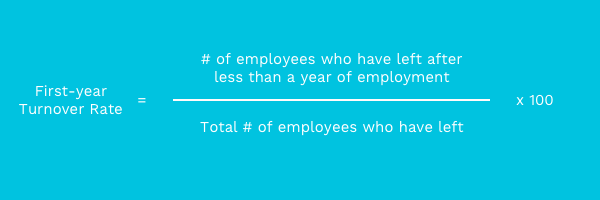The new hire retention rate is believed to be a problem with about 90% of hiring teams, and behind most of such early turnover are the failed new hire expectations.
They have expectations about the duties they’ll perform in their day-to-day job life, the working hours, company culture, and so on. However, when these expectations differ from the job reality, many of them quit.
But such failed expectations — and the resulting premature employee turnover — can be minimized, if not avoided. In fact, as an employer, you can do a lot on the job expectations and reality alignment front for your new hires, so they feel like they’re getting just what they signed up for. Did you know you can do a lot already in the recruitment phase of your hiring process?
Let’s see 10 power moves you could try to manage your new hires’ job expectations so that you’re both on the same page.
- Communicate the job well
- Design pre-hiring that sets the right candidate expectations
- Present your company culture transparently
- Stress on the career paths your new hires can chart at your company
- Help your new hires bond with their bosses or managers
- Provide a great onboarding experience
- Decode the new hire attrition pattern at your company
- Make a 90-day plan
- Make new hire retention a hiring KPI
- Communicate (clearly and often) about job expectations
Here goes!
1. Communicate the job well
You’ll be surprised to know that about 45% of new hires who quit report that their day-to-day role didn’t match what they expected.
So if you can only find a way to communicate their daily job life better to your new hires, you should be able to bring down your new hire turnover dramatically.
And you do several things here, such as:
- Write a detailed job description. Your candidates set their first job expectations when they read your job description. To set realistic expectations, your job descriptions must be detailed and clearly mention the compensation you’re offering, the day-to-day responsibilities expected of the hire, the work environment you offer and more. All this while giving insights into your company culture.
- Continue explaining the role throughout the recruitment process. Don’t rely on your candidates understanding everything about the job straight away. Keep explaining what the job is about throughout the hiring process, what you expect from the candidate and what they can expect from you.

Only
47%
of workers believe that job descriptions reflect actual job responsibilities.
Source: Jobvite
Writing a good description is not only essential to attract qualified candidates but also to start managing their job expectations.
2. Design a pre-hiring process that sets the right candidate expectations
Before someone becomes a hire, they’re just another candidate in your hiring cycle.
And it’s during this stage that they form their expectations around the position you’re hiring for. Around how well they think they’ll do in your company culture. And also around how nicely they feel they might get along with their future bosses or teammates.
Your candidates set their expectations based on how they perceive your company and the role to be. And so you should be very responsible and clear in all your communications and content around the role being filled (for example, the day-to-day duties a candidate can expect to do, the salary they’d be paid, the hours they’d have to fill, the different perks and benefits they’d get), your company culture, and the real working conditions (for example, if it’s a sales job that can be stressful, hint at that!).
Remember that the pre-hiring stage or the recruitment stage is the perfect place to start managing your new hires’ job expectations. What strategies can help you with that?
- Use realistic job previews. Provide your candidates with previews of what the job is like and how the life at your company is. These could be simple videos that walk the candidates through how a day in the life of that role at your company could be for them.
- Conduct situational judgement tests. Furthermore, you can use a bunch of situational judgement tests in your pre-hiring stages so that candidates see and go through the exact situations they could encounter on a day-to-day basis in the roles they’re pursuing.
If a candidate doesn’t like what they see in the pre-employment stage of the hiring process, they are likely to not continue it. On the other hand, a candidate who continues the process is more likely to match with the job you’re offering.
3. Present your company culture transparently
About one-fifth of new hires who leave their jobs do so because they don’t like the company’s culture.
There are two possible causes for this.
The first one is when a company lacks a well-defined company culture.
And the other happens when a company’s real culture differs from what’s perceived from the outside.
If you happen to fall in the former category, then you need to explore your company culture and define it, so that your new candidates can definitively tell if they’re a good fit.
And in the latter case, you need to work on how your company culture is perceived. For instance, if your company culture defines you as one where people care for each other and love connecting… and yet, when your new hires join, no one tries to get to know them, then that’s a letdown. Alternatively, if you have a results-driven company culture, communicate that and tone down the other niceties. Remember that there are candidates that will thrive in each of these two types of culture. But you ought to explain your culture transparently so the candidates can set the right expectations.

88%
That’s how many job seekers find company culture of at least relative importance.
Source: Jobvite
…and 32% of people who quit within the first 90 days did that because they didn’t feel it was a cultural fit. You can prevent this but showing the true colors of your company culture throughout the hiring process.
4. Stress on the career paths your new hires can chart at your company
About fifteen percent of new employees who quit do so because they don’t see a path for career advancement.
This, again, is something that you can take care of even before getting them onboard. For example, by asking questions about where they see themselves in five years or so, you can get an insight into how they expect their career trajectory to be.
If their expectations don’t meet your reality, then it’s best to say so and help them deselect themselves from your hiring process.
And if that’s possible, use the first few months of your new hires to reinforce how they can chart the career they see for themselves working for you.
The key to getting this right is being realistic.
5. Help your new hires bond with their bosses or managers
This adage says it all: “People don’t quit jobs, they quit managers.”
About fifteen percent of new hires quit jobs because of failing to “like” their bosses.
Now, this, of course, isn’t in anyone’s hands. But you can still somewhat address it during your pre-hiring stage. For instance, you can arrange hiring rounds where the candidates get to meet and greet their potential future managers and bosses. That way, they’d know if they simply “don’t click” with their managers. And if your potential hires do sense compatibility issues or feel that they might not get along so well with the managers they could be working for, they could decide to pull out from your hiring cycle at the pre-hiring stage itself.
Also, make sure your new hires get the time to connect with their managers. If they don’t get the time or if you don’t plan for such bonding, they’d still feel a disconnect and quit — without fully getting the chance to explore a working relationship with their managers.

While 92% of CEOs feel their organization is empathetic, only
50%
of their employees say their CEO is empathetic.
Source: Businessolver
Regularly check in with your new hires on how they perceive the relationships with their managers, and vice versa. It will help you discover any issues early on and act to resolve them.
6. Provide a great onboarding experience
If there’s one way to absolutely crush any potential “expectations gap” for your new hires, then it’s during the onboarding phase. This period is ideal for reassuring your candidates that they’ve landed themselves just the right job.
By making your onboarding consistent with the role and with your company and its working culture, you won’t just reinforce how well their job expectations match with their job reality, but also motivate and engage them early on.
You must also find ways to make your culture shine through your onboarding. So, for instance, if you have a people-first culture, make sure that reflects throughout your onboarding journey and your new hires feel the consistency.
7. Decode the new hire attrition pattern at your company
Analyzing your early turnover pattern and learning where the expectations gap kicks in for your new hires and what causes it is critical to addressing it in a timely manner and stopping your new hires from quitting.
For example, when a company with a workforce of about ten thousand people reported an attrition rate of a whopping 50%, they decided to dig deeper. They found in their analysis that the employees felt like their job expectations were met during the first six months. During this time, they were “… assigned a mentor, received training on how to perform their jobs and felt that their employer had laid out a clear set of expectations.” The attrition rate during this period was well under 10%.
However, at the seven-month-mark, the new hires started experiencing the “expectation gap.” Everything right from the number of hours worked and the training offered to the daily job responsibilities failed to meet the hires’ expectations. And this resulted in the record turnover at the nine-month mark.

72%
of employees who quit were unhappy with the quality of retention effort.
Source: AceNgage
How do you prevent losing your new employees? What retention programs do you have in place? Make sure that your employees feel that you are doing everything you can do keep them onboard.
8. Make a 90-day plan
Ninety days? Well, if you’re a recruiter or a hiring manager, that number would ring a bell.
After all, about three in ten new employees leave a company within just the first three months of taking up their jobs.
So make a detailed 90-day new hire plan where you focus on working with your new hires to understand how well they find their jobs to align with their expectations.
Doing so won’t just help you retain most of your new hires but it will also make all your new hires feel more engaged (and therefore more productive!) as they’ll feel like they’ve landed themselves just the job they thought.
9. Make new hire retention a hiring KPI
Retaining your new hire is like any other hiring operation that can be optimized.
But for that, you need to know your new hire attrition rate.
You can choose what you’d like to count as an early exit as there’s no industry-level standard. However, most companies consider exits within the first year as new hire exits.
Use this formula to calculate your new hire attrition rate:

Once you have the number, plug it into your recruiting dashboard and routinely monitor it.
Also, add all the feedback you collect during your new hire exit interviews to your dashboard. This will help you translate the feedback into actionable insights and study their impact on your new hire attrition rate.
10. Communicate (clearly and often) about job expectations
Most companies see new hire attrition as a serious problem. They also understand that such new hire attrition happens mainly because of failed expectations that the new hires experience.
Yes, they fail to communicate with their new hires about how their job expectations are being met. They lack a feedback loop and miss asking their new hires how consistent they find their real jobs to be with their expectations.
This doesn’t just result in missing the early signs of dissatisfaction or disengagement the new hires show (that could very well result in attrition) but also misses opportunities for building trust and rapport between the employees and the company.
Open and honest communication around job expectations and giving and taking feedback can make all the difference between new hires who quit and those who stay and work their way through the confusion or expectations gaps, if any.

89%
of HR leaders agree that ongoing peer feedback and check-ins are key for successful outcomes.
Source: SHRM & Globoforce
53% of companies have onboarding programs that take a week or less. However, such a short time spent on onboarding creates expectation gaps that might be hard to close later on. Constant feedback and check-ins are crucial to manage job expectations of the new hires and get them to be productive faster.
Next steps
As you might have realized, you can significantly bring down the instances of losing new hires by helping them set the right job expectations already in the pre-hiring stages. By writing better job descriptions, transparently communicating your company culture, and explaining your work values, you can help them set realistic job expectations.
Also, once you’ve helped them set the right expectations during the pre-hiring stage, shifting your focus on reassuring your new hires how they’re just in the right place and having an onboarding plan that addresses the job expectations and reality alignment becomes the key part of the puzzle.
Managing the job expectations of your new hires won’t just save you and your employees from disappointments but it will also start your working relationship on just the right note. When your employees feel reassured of landing just the right job that takes their career where they want to (while meeting their other expectations), they’ll engage quickly and stay with your company for longer.


